Notes
![[Portrait of a Ship Captain] by Miss Libby. Original Photo at the Library of Congress [digital photo by L. Lee McIntyre]](http://p3photographers.net/wp-content/uploads/llm-seacaptain-front-LOC_Miss_Libby-378x450.jpeg)
My quest today started with this photo that I discovered in the Library of Congress photos archives. In the LOC catalog, it’s just labeled as “[Portrait of a Sea Captain], circa 1897, creator: Miss Libby.” Note that the photo at left was taken by me with my cell phone; unfortunately, the Library of Congress does not currently have a digitized image of this photo available, but I’d like to give a huge thank you to the curators at the LOC for allowing me to take this photo to share here on the podcast.
Miss Libby’s photograph is nothing short of fantastic; my digital image taken with my cell phone doesn’t quite do it justice, but you at least can get a sense of the Captain’s image and his personality that jumps out of the image.
Also, here’s a look at the note in pencil that’s written on the back of of that photo:
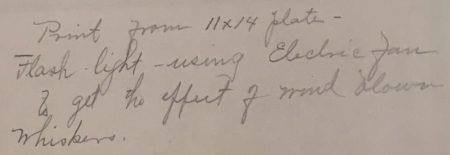
My search to find the wonderful photographer responsible for that photo led me to Norway, Maine, and the wonderful Miss Minnie F. Libby, 1863-1947. Her life and work was celebrated at the 2007 Norway Arts Festival:

The photos in that poster are from the Norway Historical Society website, and showing different stages of her life and work.
Miss Libby ran a studio in Norway, Maine from 1885-1947. Her first studio was on Deering Street, but in November 1903 she purchased the Cottage Studio, which you can see in the top-middle of the arts festival poster above.
As I talk about in today’s episode, that purchase displaced a photographer named Wiggins Merrill, leading to a war of words in ads in the local newspaper.
First, Mr. Merrill places this notice in every edition of the newspaper throughout December 1903; here’s a copy of it from December 11th:
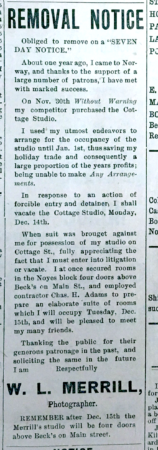
That same notice is repeated all throughout December 1903. On December 25th, Wiggins inserts his notice again. But on a separate page in the same newspaper, Miss Libby fires back her response:
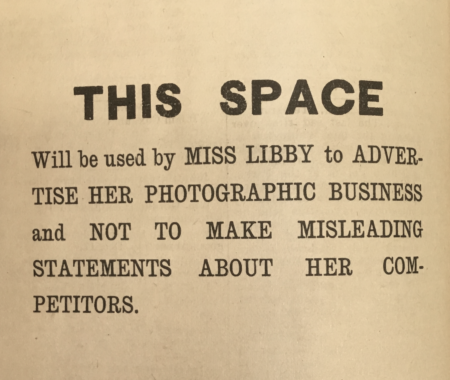
Miss Libby’s work encompassed the gamut of types of photographic output over her 60+ year career, including her studio work of portraits of men, women and children.

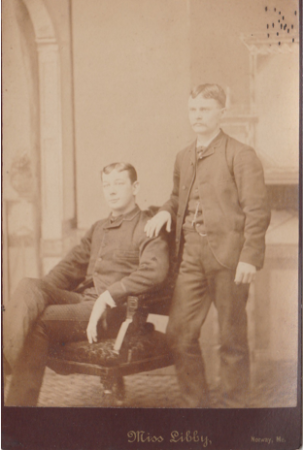
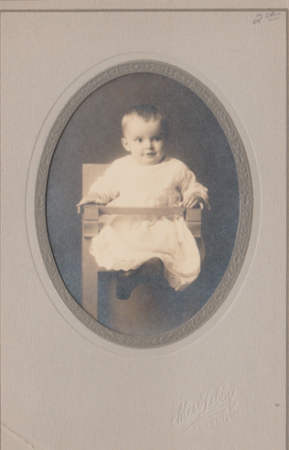

Some of her most striking non-studio work are her retouched (“colorized”) landscapes, with scenes of the lakes surrounding Norway, as well as explorations of the artistic photography ideas of pictorialism and multiple exposure (topics that I have discussed in other episodes related to the works of Gertrude Käsebier, Margaret DeMotte Brown, and Hannah Maynard. For a more complete discussion of Miss Libby’s life and work, including all aspects of her types of photographs, I refer you to the biography written by David Sanderson, which is available online here.
Miss Libby’s skill as a photographer, and life as an independent businessman is the consummate example of the type of early women artisan photographer that we celebrate here on Photographs, Pistols & Parasols. Many thanks to Charles Longley and all the people at the Norway Historical Society, as well as the folks at the Norway Library, my Airbnb host Lisa Moore, and Sally Jones, the local volunteer/actress – you all brought Minnie Libby to life for me last summer on my visit to Norway, Maine. I, for one, will never forget her!
Lifeline
Recommended Links
Transcript
You’re listening to Photographs, Pistols & Parasols.
Support for this project is provided by listeners like you. Check out my website at p3photographers “dot” net for ideas on how you, too, can become a supporter of the project.
Welcome to Photographs, Pistols & Parasols, the podcast where we celebrate early women artisan photographers.
I’m your host, Lee McIntyre.
In today’s episode we’re going to meet the remarkable — and unforgettable! — Miss Minnie Libby.
For more information about any of the women discussed in today’s episode, visit my website at p3photographers “dot” net. That’s letter “p”, number “3”, photographers “dot” net.
—–
Today’s story starts with a photograph.
It’s a picture of an elderly gentleman who has gray hair and a flowing beard. On his head he has a sailor’s cap, and he’s wearing the jacket, and posed next to a ship’s wheel, that marks him as a sailor.
Indeed, the caption on the photo in the Library of Congress catalog where I first saw it, is marked “Portrait of a Ship Captain.”
The photo is remarkable in its clarity. It’s 11 x 14, which is fairly large, and the catalog says that it’s circa 1897.
The background is painted clouds, but the portrait really reveals a personality of a ship captain — you can imagine chatting with him!
Every detail, every line in his face, everything just jumps out of that photograph.
It is truly just remarkable, given, as I said, the size and the date, which is 1897.
But what was also remarkable (when I first ran across this image) was noticing the pencil marks on the back. Written there in pencil, the photographer has written, “Print from 11 x 14 plate; flash-light; using electric fan to get the effect of wind-blown whiskers.”
Well, I was blown away by this photograph, and I was really intrigued, because the creator of the photograph is labeled just as “Miss Libby”.
My quest then became to find out who the heck was this fantastic photographer “Miss Libby”.
Since I was looking at this 19th century photo in the 21st century what you might expect, and I went to the Internet.
Looking on the Internet actually revealed something quite astonishing, because I ran across a woman named Minnie Libby.
Now, Minnie Libby was a woman who lived in Norway, Maine, and the Norway, Maine Historical Society has a wonderful website where they actually profile this local photographer, Minnie Libby.
Now, also in the Internet, I was able to uncover a biography of Minnie Libby, written by a man named David Sanderson for the Norway, Maine summer arts festival in 2007.
As it turns out, not only has the Norway Historical Society celebrated Minnie Libby on their website, but in fact the town celebrated her and made her the focal point of the 2007 arts festival.
And this was just incredible to discover.
So, what I’m going to tell you today, I’ve gathered from the materials that I found on the Internet — and I’ll explain a little bit more about those materials as we go along.
But also, I had the opportunity last summer to actually go to Norway, Maine and talk to the local archivist there, Charles Longley, as well as some of the people in town who organized the arts festival.
And thanks to my wonderful Airbnb host, Lisa, I got to actually meet Miss Libby!
Well not quite Miss Libby, but a woman who dressed up as Miss Libby, a woman named Sally, who actually portrayed Minnie Libby [at the arts festival in 2007], and she told me a few stories that she uncovered in 2007.
I want to start by just reading you the beginning of David Sanderson’s bio.
So David Sanderson starts his biography of Minnie Libby by saying,
“Miss Libby, she was she was born during the Civil War and still lived to see the end of World War II, born in 1863, dying in 1947.
“Her 60 year career as a Norway business owner would have been notable in and of itself. But she was also a photographer and an artist of some ability, with a share of eccentricities that were generally accepted, even appreciated by her neighbors.”
Minnie Libby was indeed a local character there in Norway, Maine.
She was known for walking around town always wearing knickers, a suit coat, and a flowing tie.
And, again, I’ll link to a picture of her that’s on the Norway historical society’s website
But in talking with Charles and others at the archive, it’s clear that even though Minnie Libby was an eccentric — I mean she was born in the 19th century, and walking around town always in pants or trousers was really something remarkable for women of that generation.
But as Sally, the woman who dressed up as Minnie Libby explained to me, this was something that people just grew accustomed to and knew that that’s who Minnie Libby was.
She was renowned as a local photographer, and people came and patronized her studio for over 60 years.
Now, Charles the archivist there at the Norway Historical Society, remembers actually seen Minnie Libby walking around town, and asking his mother, “Who is that woman – or who is that person walking around looking like that?!”
And Sally, who dressed up as Minnie Libby, said that one of the descendants of one of Minnie Libby’s assistants actually told the story that had been told her by her father.
There was a day when the two of them [Minnie and her assistant] had to go into Portland, the big town nearby to do some business.
And Miss Libby’s assistant was a little bit nervous about going with her when she was dressed as a man, essentially.
And so he said maybe she should put on a dress or a skirt.
So Miss Libby goes into her room, comes back out, and she’s wearing a skirt.
So they go off to Portland.
They transact their business there.
And when it comes time to pay, Minnie Libby has to get her wallet.
So she hikes up her skirt and reveals that she’s actually still wearing her trousers underneath; her wallet was in the pocket of her trousers, so she had to dig it out while she hiked up her skirt.
This was the local legend about Miss Libby — that she just went her own way.
But more than her eccentricity, she is celebrated there in Norway for her artistry.
Unfortunately she didn’t actually keep examples of her work, and so the collection they have at the Norway Historical Society is one that they have been trying to amass over the last few decades, as they try to reconstruct her work and her life.
There many different kinds of examples in the Norway Historical Society collection — everything from cabinet cards and other studio photographs; to postcards taken at the local county fair and sold at the fair; to landscapes and pictures in nature; pictures of store fronts, and also retouched photographs, photographs were she has actually painted in to make them colorized, even when the original photograph was black and white.
There are a few just gorgeous examples of those kinds of re-touched landscapes that are hanging at the Norway Historical Society in Maine.
Now, miss Libby actually trained first as an artist‚ her father, Hiram, was not an artist himself, but he was extremely supportive of his only daughter’s ambitions to become an artist.
And so, at the age of sixteen, she went off to Boston to study art.
But in 1882, after a few years in Boston, she returned to Norway and started working for a local photographer named J.U.P. Burnham, working for him as a retoucher.
By 1885 she’s ready to open her own studio, which is originally on Deering Street.
In 1904, after having a success in that little Deering street location, she moves to a bigger space on Cottage Street, and her studio becomes known as the Cottage Studio.
One of curious things about the Cottage Street Studio is that it actually had been around as a photography studio for many years, including when Minnie Libby was working at the Deering Street location.
By the time Miss Libby actually buys that space, there’s another photographer, Wiggins Merrill, who has been renting that space from the person who owns it (who had moved to Massachusetts).
The person who owns sells to Miss Libby and her father, but neglects to tell Wiggins Merrill — the photographer who’s been renting that space — that the studio’s been sold out from under him.
Mr. Merrill is not happy when he finds out that he has just a couple of weeks to vacate the space, because the sale happens in November, right at the beginning of the Christmas season.
And this is when Mr Merrill is hoping to make all his money. So, he is not happy with Miss Libby.
He takes out huge — almost full column! — notices in the newspaper in Norway, Maine, all through December, complaining about his treatment at the hands of his not-named-in-the-notice competitor.
But it’s clear who he means, and he is just fit to be tied. I mean, he says he’d only got seven days notice, he had to scramble, they are interfering with his business right there at the Christmas season…
Anyway, he lands on his feet: he manages to find other space to open by December 15th that year, so he’s only actually closed for a couple of weeks.
But that ad continues to run even when he re opens.
So, by December 25th, 1903, Miss Libby has had enough.
And so, her rebuttal in a very small boxed notice in the newspaper reads:
“This space will be used by Miss Libby to advertise her photographic business and not to make misleading statements about her competitors.”
I just love that! A great put down and really putting Mr. Merrill in his place.
Now eventually apparently they made up somehow, because a couple of years later, Mr Merrill actually buys the old Deering Street location where Miss Libby had opened her at studio.
So, effectively they wound up swapping their locations.
But even though there are a lot of photographers in town at the turn of the century, by 1906 Miss Libby is the last photographer left standing there.
Now, she actually ran a photography studio in Norway, Maine for over 60 years.
The first location she opened in 1885, and then that second location she opened in 1904.
She ran that location — that Cottage Studio — right up until 10 weeks before she died in 1947.
As I may have mentioned before, she didn’t keep copies of her work, and unfortunately all of the negatives that she had of her work were destroyed; they were just thrown out after she died in 1947.
But as I said the Norway Historical Society has managed to put together a collection of her work which really represents all the different kinds of people and places she took pictures of.
There are photos of couples, of children, of events — it’s really capturing the life of the town.
I mean, you have pictures of babies, and then, when those babies have grown up, you have pictures of those people’s babies.
Miss Libby also had an artistic side to her photography that goes beyond the studio work.
As I said, she has these beautiful landscape photos that the Norway Historical Society has some excellent examples of.
She also flirted with artistic style called Pictorialism, which I’ve talked about back in the Gertrude Käsebier episode, and also in the Margaret Demotte Brown episode.
It was the idea of creating a picture that represents a scene that would have been in a painting.
So there is something that Miss Libby has that David Sanderson talks about, that shows that she probably was experimenting with that as well.
Over the course of her career she apparently didn’t really seek out fame.
She was locally well-known.
She even had multiple locations, not just that location in Norway, but for a time some cabinet cards actually say she had a second location in Harrison, Maine.
That’s a local summer place where people would go for vacation.
Miss Libby apparently set up a stall there, although I have not been able to track down much more information about her work there.
But there’s no indication in any of the Harrison directories that she ever had a permanent location there; her main location was always in Norway.
Now in 1940, there’s actually a profile of her in a Life magazine article that talks about her as being this wonderful photographer, in business at that point for fifty years, pointing out the fact that she had been the artisan photographer there, really cataloging the life of that town.
One of the other things to note about Miss Libby is that she interacted with other artists in town.
As I said, said there were a lot of photographers [in Norway] initially but not after 1906.
But there are other painters and artists.
That Merrill – remember, he bought the original Deering street studio that Miss Libby had first occupied?
But then eventually he sells it, and it winds up in the hands of a man named Vivian Akers, who is a somewhat famous local artist there in Norway. who became a photographer and painter
Vivian Akers actually had his portrait taken by Miss Libby when he was a child.
When he was all grown up and a portrait painter himself, he painted a portrait of Miss Libby, and right now if you go to the Norway Library you’ll see this beautiful portrait of Miss Libby painted by Vivian Akers, prominently displayed above the stairs.
All of the material I’ve talked about so far I learned either from the Norway Historical Society, from the website, from the David Sanderson biography, or from talking with people there in Norway.
But the next thing I want to bring up that was something that was fun to find, and fun to bring to the Norway Historical Society’s attention. It was an article that I ran across doing a search of the digitized newspapers are now available in the Library Congress.
As I’ve mentioned repeatedly on this podcast, a lot of my research starts by finding newspaper articles or other digitized records for people.
In Miss Libby’s case, the Norway Historical Society had already found a lot of the local materials.
But in this one case, there was in 1907 article that actually didn’t really appear in the local papers — it appeared all over the US!
It started in New Mexico of all places.
So, the Albuquerque Evening Citizen paper, in March of 1907, commissioned an article on a town in the US that they’d heard about where most of the professions in town were actually filled by women in those roles.
So, the justice of the peace, the doctor in the town, the minister in town and the photographer in town and in addition to a few other occupations — these are all roles being done by women.
This article was a profile of the town of Norway, Maine — and, of course, the photographer that they talk about is Miss Minnie Libby.
In the article it talks about how the women are really running the town.
And so when the article is picked up by the wire services later on, it is invariably titled “The Town Ruled by Women.”
So we started with a photo in the Library of Congress that I happened across, that just was identified as Miss Libby.
My investigation eventually led me to Norway,Maine, with their wonderful website about Miss Libby.
And then, also finding additional materials about Miss Libby led me to the wonderful article found in the digitized newspaper materials of the Library of Congress.
I think that for me, this search for Miss Libby really illustrates the power of being able to do research in the 21st century, since we have all this information at our fingertips, and you can try to piece together more information to find out the background about something that you’re really intrigued about.
I also really want to thank Charles Longley at that Norway Historical Society for sitting with me one afternoon to find the actual ads in the newspaper there the 1903, to show what was going on between Wiggins Merrill and Miss Libby.
I also want to thank again all the other people who I talked with at the Norway Historical Society, and other neighboring historical societies, including Lewiston [Maine[, Harrison [Maine]
And also, of course, Sally, and my landlady, Lisa, for helping to introduce me to Minnie Libby.
By the way, a couple more quick notes.
Remember I said that the label in the Library of Congress called that photo “Portrait of a Ship Captain”? Well, it turns out that the unnamed man in that portrait — unnamed in the Library of Congress catalog — actually has a well-known name when you talk to the people in Norway.
It turns out that the man is Captain Ed Ames, and he was a steamer captain on the Pennesseewassee Lake there in Norway.
Oh, and remember there was note about the electric fan?
Well, in the Life magazine article, they say that Miss Libby was the first person in Norway to actually have electricity installed.
Now, of course, she didn’t have it installed at her home, she had it installed in her studio, so that she could use things like electric “flash-light”… and also of course the electric fan.
All the materials that I’ve mentioned about Miss Libby or also any of the other women I mentioned today, you can find those materials over on my website, at p3photographers “dot” net. That’s letter “p”, number “3”, photographers “dot” net.
If you have any questions about any of the material today or anything about the podcast, drop me a line at podcast “at” p3photographers.net.
Over on my Facebook page I’m going to be posting a little bit of material that I couldn’t quite fit in today.
It’s a curious story involving a male photographer who was a contemporary of Miss Libby, but whose disappearance caused quite a stir in the 1890s.
Look for that over at my Facebook page at facebook.com/p3photographers.
Support for this podcast is provided by listeners like you. Check out my website at p3photographers “dot” net for ideas on how you, too, can become a supporter of the project.
That’s it for today.
Until next time, I’m Lee, and this is Photographs, Pistols & Parasols.
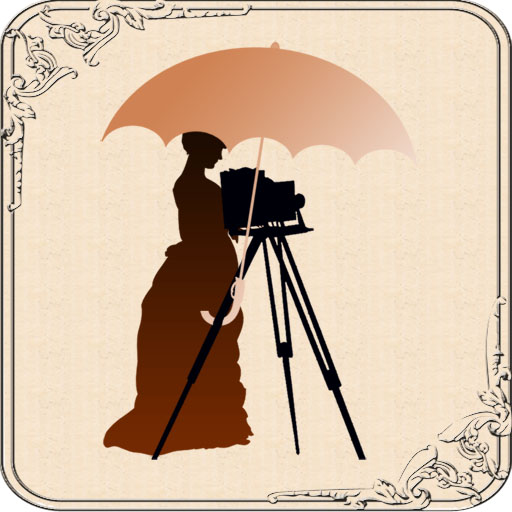

2 thoughts on “14 The Unforgettable Miss Minnie Libby”
Comments are closed.